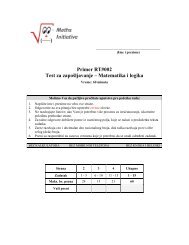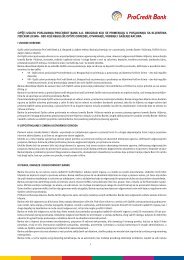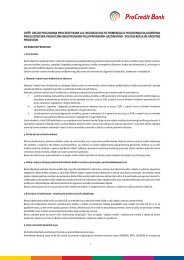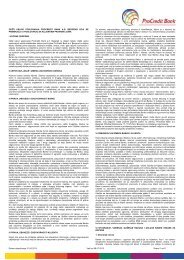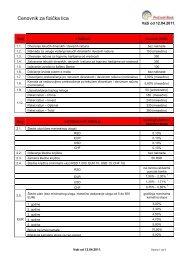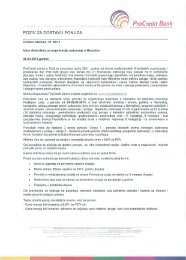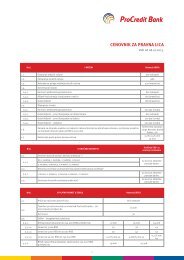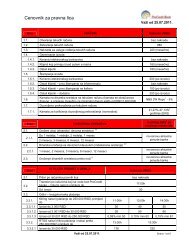Annual Report 2010 - ProCredit Bank
Annual Report 2010 - ProCredit Bank
Annual Report 2010 - ProCredit Bank
- No tags were found...
You also want an ePaper? Increase the reach of your titles
YUMPU automatically turns print PDFs into web optimized ePapers that Google loves.
Management Business Review 19<br />
partners IFC, EFSE and KfW. <strong>ProCredit</strong> Holding’s<br />
deposit exposure remained at the previous year’s<br />
level of EUR 25 million.<br />
shortfalls, as the current account deficit is expected<br />
to remain relatively high, requiring significant<br />
capital inflows to maintain external balance.<br />
Total operating income for the year was RSD 4.9<br />
billion (EUR 46.2 million), of which net interest<br />
income contributed 93.8%. Compared to the previous<br />
year, interest income decreased by 9.5%<br />
to RSD 7.3 billion (EUR 69.3 million). This was a<br />
consequence of the bank’s decision to introduce<br />
a minimum loan size of EUR 2,000, which meant<br />
discontinuing our lending operations in the<br />
smallest loan size range, where interest income<br />
was highest but operational expenses and risk<br />
were also highest. Interest expenses decreased<br />
by 21.2%, reflecting the success of the bank’s efforts<br />
to access less expensive sources of funds.<br />
The NBS has already responded to rising inflation<br />
by tightening monetary policy – raising reference<br />
interest rates and mandatory reserve requirements<br />
– and will continue to pursue this course<br />
in 2011. GDP growth is projected at 3%, 11 while a<br />
budget deficit of about 4% of GDP is forecast.<br />
The slow progress of growth-oriented structural<br />
reforms is an important issue for the authorities.<br />
With an eye to elections due to be held in 2012,<br />
the government’s short-term plans are focused<br />
on restructuring the public utilities and on fiscal<br />
stabilisation.<br />
Net fee and commission income, including the<br />
trading result, slightly decreased to RSD 1.2 billion<br />
(EUR 11.5 million). The operating result before<br />
tax amounted to RSD 506.3 billion (EUR 4.8<br />
million), 41.8% short of the 2009 figure.<br />
Operating expenses increased by 1% to RSD 4.4<br />
billion (EUR 41.4 million) compared to the previous<br />
year, but this picture was slightly distorted by<br />
the one-time reorganisation expenses incurred in<br />
<strong>2010</strong>. Without these costs, the decrease in operating<br />
expenses would have been more significant.<br />
The full effect of increased cost awareness among<br />
staff, coupled with the network reorganisation<br />
and optimisation undertaken in <strong>2010</strong>, is expected<br />
to be reflected in cost savings in 2011. The costincome<br />
ratio rose from 71.3% in 2009 to 74.4%.<br />
The bank ended <strong>2010</strong> with a net profit of RSD<br />
445.2 million (EUR 4.2 million), which, although<br />
44.9% down on the previous year’s result,<br />
nonetheless meant a sustainable return on equity<br />
of 5.17%. Shareholders’ equity remains the<br />
strong foundation on which the bank’s stability<br />
rests and its capital adequacy remained high at<br />
17.31%, well above the local requirement of 12%.<br />
Outlook<br />
The banking sector is still well capitalised, and<br />
should be able to absorb even a protracted corporate<br />
restructuring process. Many banks are expected<br />
to reorganise their processes: given that by the<br />
end of 2011 banks will be obligated to implement<br />
Basel II-compliant policies and procedures, risk<br />
management processes will be more comprehensive<br />
and demanding, and more stringent capital<br />
requirements will have to be met.<br />
As <strong>ProCredit</strong> <strong>Bank</strong> has already completed its reorganisation,<br />
it will be in a strong position to take advantage<br />
of market opportunities and increase business<br />
volumes while remaining within the defined<br />
risk limits. Our strategy for 2011 is geared towards<br />
increasing market share in the Small business segment<br />
by offering a wide range of services, including<br />
financing, liquidity management, documentary<br />
business and transaction processing. Our aim is<br />
to be the leading bank for sustainable, growing<br />
enterprises. At the same time, we will continue to<br />
promote a culture of savings, emphasising the clarity,<br />
simplicity and security of our savings products.<br />
And in our transaction business, the focus will be<br />
on efficiency, convenience and the appropriate use<br />
of innovative technology. The bank is aware that it<br />
will need to continually adapt its business to fluctuating<br />
market conditions in order to achieve satisfactory<br />
financial performance.<br />
In 2011 Serbia is likely to face two main macroeconomic<br />
challenges: inflation, which rose above<br />
the target level in the second half of <strong>2010</strong> and is<br />
expected to remain high; and external financing<br />
11<br />
Republic of Serbia: Sixth review under the Stand-by<br />
Agreement, www.imf.org



